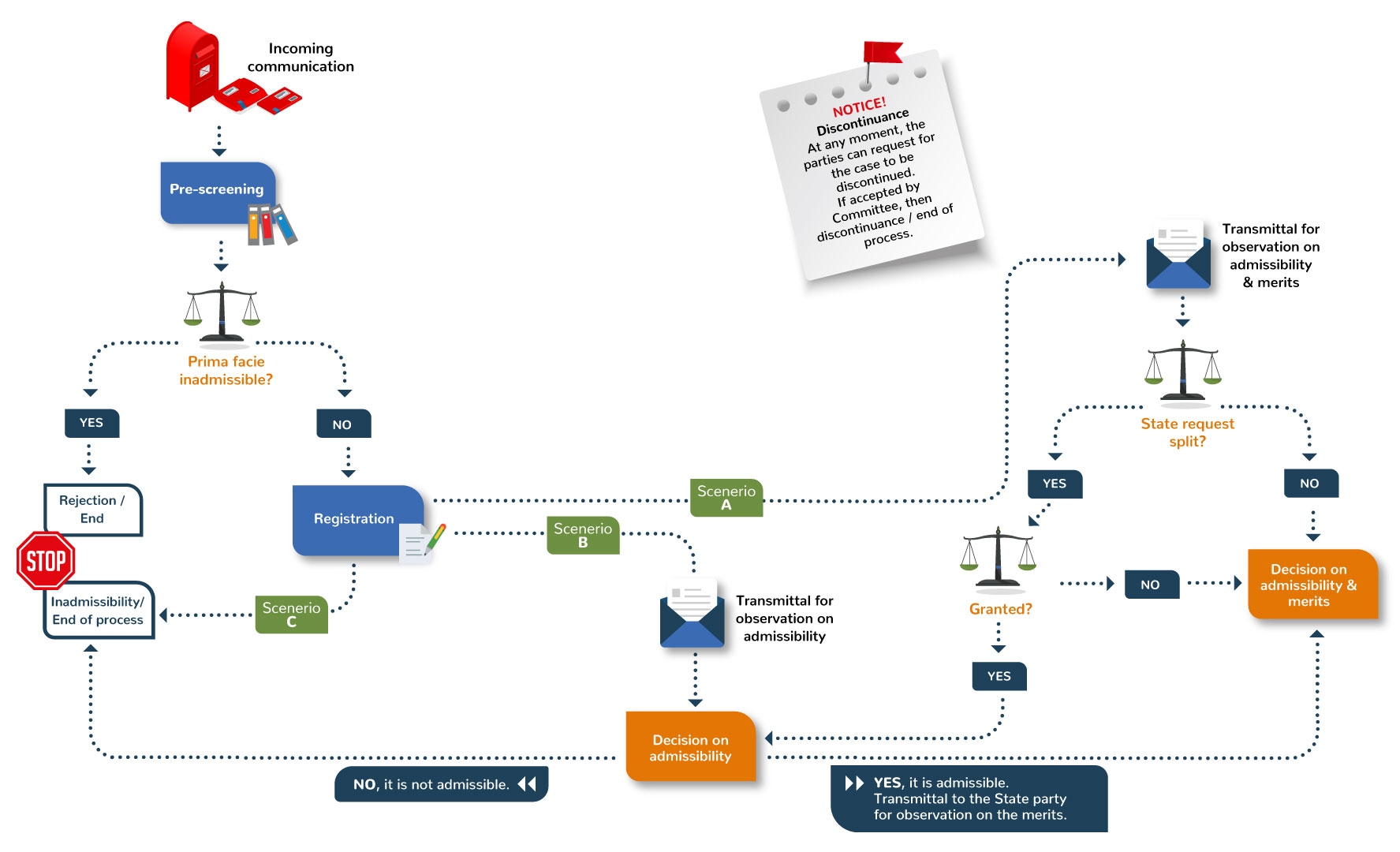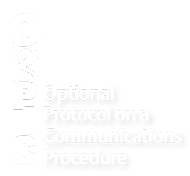The Mechanisms
The Mechanisms
Under the OPIC, violations to the rights of the child can be brought to the attention of the Committee on the Rights of the Child through two procedures:
-
- The Communications Procedure and
- The Inquiry Procedure
The Communications Procedure
1. Individual communications (article 5 of the OPIC)
This procedure, also called ‘complaints procedure’, allows for children, groups of children or their representatives, who claim that their rights have been violated to bring a complaint or communication before the Committee on the Rights of the Child (the Committee).
Violations can only cover the rights guaranteed under:
-
- the Convention on the Rights of the Child (UNCRC) and/or
- the Optional Protocol to the UNCRC on the involvement of children in armed conflict (OPAC) and/or
- the Optional Protocol to the UNCRC on the sale of children, child prostitution and child pornography (OPSC)
The violation must have been committed by a State that is party (i.e. has ratified) to the UNCRC, the OPAC and/or OPSC. States must have also recognised the competence of the Committee to receive such complaints through ratification of or accession to the OPIC.
Before submitting a communication, the complainant must first ‘exhaust domestic remedies’, i.e. bring his/her case before national jurisdictions and obtain a final decision, except if he/she can demonstrate that domestic remedies are ineffective or unreasonably prolonged. In addition to the exhaustion of domestic remedies, other admissibility requirements must be met before the Committee can review an individual communications. These are listed in article 7 of the OPIC.
For more information please refer to: How to submit an individual communication.
The individual communications procedure is a quasi-judicial mechanism and the resulting adopted Views when a violation is found imposes an international obligation for States parties to comply with them. Indeed, by becoming a party to OPIC, the State has committed itself to follow them and provide redress to the victim(s).
Did you know?
Admissibility requirements explain why a considerable number the communications received by the Committee do not make it to registration. By September 2019, the Committee had received more than 300 individual communications, of which 99 were registered.
Stages of the Communications Procedure
The Communications procedure involves several stages, read below to know more about them.

Stages 1 & 2: Reception of an individual communication, pre-screening and registration
Unless a communication falls under this category, it will be registered.
Stage 3: Transmission to State party for observations/ Request of interim measures
Registered communications are transmitted to the State against which the complaint was filed, which will be asked to submit its written observations and comments (Rule 18.1 of Rules of Procedure of the OPIC) as soon as possible and within six months after receipt of the Committee’s request for observations.
In exceptional circumstances, and to avoid possible irreparable damage to the victim(s) of the alleged violations, the Committee can also transmit to the State party concerned a request for its urgent consideration that the State party takes necessary interim measures (IM). The request of interim measures does not imply a determination on whether the communication is admissible nor on the merits (substance) of the communication (article 6 of OPIC).
The State party has to submit to the Committee written explanations or statements that relate to the admissibility and the merits (substance) of the communication (Rule 18.3 of the Rules of Procedures). (Scenario A in rectangular flowchart below.)
The Committee can however also request to the State party written explanations or statements that relate only to the admissibility of a communication (Rule 18.4 of the Rules of Procedures). (Scenario B in rectangular flowchart) [In this case, after receiving comments from the State as well as the authors of the communication, the Committee will take a decision only on the admissibility of the communication.]
Split request
A State party that has received a request for observations from the Committee can also submit a request in writing that the communication be rejected as inadmissible, setting out the grounds for such inadmissibility, provided that such a request is submitted to the Committee within two months of receiving the information request by the Committee. [If the Committee grants the Split request, after receiving comments from the State as well as the authors of the communication, the Committee will take a decision only of the admissibility of the communication.]
Inadmissible Communications
Please see scenario C in flow chart below.
In rare circumstances, registered communications can be directly declared inadmissible for not meeting admissibility requirements of article 7 of the OPIC. Hence, they will not be transmitted to State parties for their comments. The process for these communications ends here.
Stage 4: Communication between the parties
During the whole procedure, and before any decision is reached regarding the admissibility and merits of the communication, the observations of the author(s) of the complaint and the State party will be shared with the other party who will have the opportunity to provide its comments.
Discontinuance
At any moment, the authors of a communication can request for the case to be discontinued. The Committee will decide on such request. If it considers the case should be discontinued it will adopt a decision in that regard, indicating the grounds for the discontinuance.
Stage 5: Examination by the Committee
Based on the information received from both parties, the Committee will proceed to the examination of the admissibility and/or merits of the case in closed meetings. It will then take a decision on the admissibility and/or the merits.
Stage 6: Adoption and publication of Views/Inadmissibility decisions or discontinued cases
The adopted Views and recommendations of the Committee, as well as the decisions of inadmissibility or discontinuance, will be transmitted to the parties, and published on the Committee’s webpage.
Two years is currently the average time for the Committee to adopt a View on an individual communication since its registration.
Stage 7: Follow-up on the decision
The OPIC provides for a follow-up procedure to monitor the measures the State concerned has taken in response to the views and recommendations of the Committee. Learn more about the follow-up procedure.
Flowchart on stages of an individual communication.
2. Friendly settlement (article 9 and 12.3 of the OPIC)
The friendly settlement procedure allows the complainant and the State party to agree on a solution with regards of the communication. Hence, this settlement terminates the procedure without a decision of the Committee on the alleged violation.
The duties of the Committee consist in providing good offices and assistance to the parties and, once an agreement has been reached, to ensure that it is it not contrary to the UNCRC, the OPAC, the OPSC, nor to the best interest of the child.
The friendly settlement procedure can be triggered by a request from one of the parties at any moment between the receipt of the communication and the determination of the merits by the Committee. However, the procedure is voluntary and the parties expressly have to accept it. The dialogue can be brought to an end by the Committee if it concludes that the matter is not susceptible to reach a solution or if one of the parties withdraws its consent or does not display the necessary will to reach a friendly settlement.
Did you know?
The Committees encourages children’s submissions, giving communications submitted by them every opportunity to prosper. It also makes an effort to respond to every child in a child friendly letter as soon as possible (in less than two weeks). By September 2019, the Committee had received 6 cases submitted (exclusively) by children.
3. Inter-State communications (article 12 of the OPIC)
If a State party to OPIC makes a declaration accepting inter-state communications, another State party to OPIC, which has also made that declaration, will be able to submit a communication against that State.
Just like in the individual communication procedure, violations can only cover the rights guaranteed under:
-
- the Convention on the Rights of the Child (UNCRC) and/or
- the Optional Protocol to the UNCRC on the involvement of children in armed conflict (OPAC) and/or
- the Optional Protocol to the UNCRC on the sale of children, child prostitution and child pornography (OPSC)
Similarly, to be reviewed by the Committee, the violation must have been committed by a State that is party to the treaty which was allegedly violated (the UNCRC and/or the OPAC and/or OPSC).
The Committee may also assist both States in reaching a friendly settlement to the matter.
Protection measures & interim measures
The OPIC contemplates protection measures to ensure that individuals under States parties’ jurisdictions are not subjected to any human rights violation, ill-treatment or intimidation as a consequence of bringing communications to the Committee, or because of other forms of cooperation with the Committee pursuant to the OPIC (article 4 of OPIC). If the State does not take all appropriate measures to protect those individuals, the Committee may request the State to urgently take such measures and to submit written explanations to the Committee about the situation. Compliance with the Committee’s request will be monitored and, where needed, the Committee may issue public statements and take any appropriate action.
Similarly, in exceptional circumstances, and to avoid possible irreparable damage to the victim(s) of the alleged violations, the Committee can request a State party to adopt interim measures (article 6 of the OPIC) such as the suspension of judicial or administrative decisions (e.g. deportation of irregular migrants), until it makes a final decision on the substance of the communication. This is to prevent actions that cannot later be undone.
Interim measures are measures taken provisionally to ensure that the right to complain and seek a remedy at the international level is not rendered ineffective through irreparable damage to the complainant.
Interim measures can be requested by the authors of a communication, in which case the Committee has 24 hours to decide if it will transmit the request to the State or not (Working methods to deal with individual communications received under the OPIC, paragraph H.21).
The request of interim measures does not imply a determination on admissibility nor on the merits (substance) of the communication. The criteria used by the Committee to decide on interim measures requests is explained it its guidelines on interim measures.
! Interim measures may also be requested to a State party at any time during the procedure and before the Committee reaches a determination on the merits (substance) of an Inter-State communication or on the findings of a inquiry. (Rule 7.1 of the Rules of procedure)
If the Committee requests the State to take interim measures, it will monitor compliance with its request and may also issue public statements in this regard.
Non-compliance with requests of interim measures have been considered a violation of article 6 of the OPIC.
The Inquiry Procedure (article 13 and 14 of the OPIC)
The inquiry procedure is a mechanism allowing the Committee to investigate allegations of grave or systematic violations of the UNCRC and/or the OPSC and/or the OPAC by a State party to these instruments, if the State concerned has ratified the OPIC and accepted its inquiry procedure.
The inquiry procedure is an optional mechanism: article 13.7 of the OPIC allows States parties to the OPIC to “opt-out” from the inquiry procedure by making a declaration, while article 13. 8 allows States parties that opted-out to withdraw that declaration.
To initiate inquiry procedures for grave or systematic violations, the exhaustion of domestic remedies is not required, nor is the identification of the victims.To submit an inquiry see details of requirements here.
If the Committee receives reliable information indicating grave or systematic violations of children’s rights, it can decide to conduct an inquiry.
Did you know?
As of October 2021, the Committee has concluded one inquiry concerning Chile and is currently working on four inquiries. During its 87th session (17 May – 04 June 2021), the Committee decided to establish a specific Sub-group on Inquiries, which is preparing the draft Working Methods for Inquiries.
Stages of an inquiry procedure
Reception of information indicating grave or systematic violations
The Committee can receive information indicating grave or systematic violations of the UNCRC and/or the OPAC and/or the OPSC by a State party to these instruments and to OPIC, by any person or organisation, including children and NGOs.
! An inquiry can also be initiated at the own initiative of the Committee.
Rule 31 of the Rules of procedure
Request of observations from State
The Committee then invites the State party concerned to cooperate in the examination of the information and to submit observations without delay with regard to the information received. (article 13.1 of the OPIC)
Decision to launch inquiry
Taking into account any observations made by the State party concerned, as well as any other reliable information available to the Committee, the latter will decide whether an inquiry procedure to investigate such violations should be launched or not. (article 13.2 of the OPIC)
! The cooperation of the State party is sought at all stages of the inquiry, which is conducted confidentially.
(article 13.3 of the OPIC).
Possible visit to territory of State party concerned
Where warranted, and with the consent of the State party, the inquiry may include a visit to the territory of the State party concerned. The modalities of the visit will be defined with the State. (Rule 38 of Rules of procedure). During country visits members of the Committee can meet with government representatives, civil society representatives and alleged victims in the country. It can also visit specific places (e.g. detention centres and prisons).
! While the cooperation of the State party concerned shall be sought at all stages of the inquiry procedure, the Committee can undertake an inquiry without their approval or cooperation once the State accepted this mechanism under article 13.7 of the OPIC. Country visits, however, can only be conducted with the consent of the State concerned.
Report on findings and recommendations
Follow-up
Article 14 of the OPIC lays out follow-up measures to the inquiry procedure, which can lead to constructive initiatives between the State and the Committee. For more information please refer to Follow-up.


